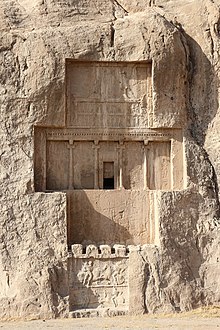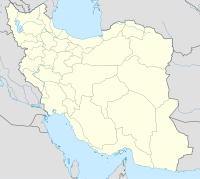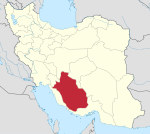Tomb of Darius the Great

29°59′20″N 52°52′29″E / 29.98889°N 52.87472°E
| Tomb of Darius the Great | |
|---|---|
 Full-scope view of Darius I's tomb at Naqsh-e Rostam, 2016 | |
| Religion | |
| Affiliation | Zoroastrianism |
| Region | Persis |
| Location | |
| Location | Marvdasht, Fars |
| Country | |
| Architecture | |
| Type | Achaemenid |
| Inscriptions | DNa inscription |
| Materials | Stone |
The tomb of Darius the Great (or Darius I) is one of the four tombs for Achaemenid kings at the historical site of Naqsh-e Rostam, located about 12 kilometres (7.5 mi) northwest of Persepolis in Iran. They are all situated at a considerable height above ground-level.
The tomb
[edit]
One of the tombs is explicitly identified by an accompanying inscription to be the tomb of Darius I (r. 522–486 BCE). The other three tombs are believed to be those of Xerxes I (r. 486–465 BCE), Artaxerxes I (r. 465–424 BCE), and Darius II (r. 423–404 BCE); the fifth tomb (incomplete) might be that of Artaxerxes III (r. 358–338 BCE) or the last Achaemenid king, Darius III (r. 336–330 BCE). The tombs were looted extensively following the conquest of Persia by Alexander the Great.
The inscriptions
[edit]DNa inscription
[edit]An inscription by Darius I, dating from c. 490 BCE and generally referred to as the "DNa inscription" (Darius Naqsh-i Rostam inscription "a") in scholarly works, appears in the top-left corner of the façade of his tomb and mentions his conquests as well as his various achievements. Its exact date is not known, but it is assumed to be from the last decade of his reign.[1] Like several other of Darius' inscriptions, the territories controlled by the Achaemenid Persian Empire (which reached its territorial zenith under Darius' rule) are clearly listed.[2]
| English translation | Original |
|---|---|
|  |
DNe inscription
[edit]
The nationalities mentioned in the DNa inscription are also depicted on the upper registers of all the tombs at Naqsh-e Rostam (starting with the tomb of Darius I) as a group of 30 Achaemenid soldiers who are in their native clothing and bearing weapons while supporting the platform on which the King of Kings stands for his devotion to Ahuramazda, the highest deity of Zoroastrianism.[6][7] One of the best preserved friezes is that of Xerxes I.
All of the 30 soldiers on the tomb of Darius further have trilingual labels over them for their ethnic identification, known collectively as the DNe inscription (Darius Naqsh-i Rostam inscription "e") in scholarly works.[8] One of the last rulers of the Achaemenid dynasty, Artaxerxes II (r. 404–358 BCE), also uses the same labels over the soldiers as depicted on his own tomb in Persepolis.[9] These are known collectively as the "A2Pa Inscription".
The inscription identifies the ethnicity of all 30 soldiers:
The nationalities of the soldiers depicted on the reliefs and mentioned in the individual labels of the DNe inscription are, from left to right: Makan, Persian, Median, Elamite, Parthian, Arian Bactrian, Sogdian, Choresmian, Zarangian, Arachosian, Sattagydian, Gandharan, Hindush, Saka (Haumavarga), Saka (Tigraxauda), Babylonian, Assyrian, Arab, Egyptian, Armenian, Cappadocian, Lydian, Ionian, Saka "beyond the sea", Skudrian (Thracian), Macedonian, Libyan, Nubian, and Carian.[8][10]
Gallery
[edit]Naqsh-e Rostam نقش رستم | |
|---|---|
Location within Iran | |
| Coordinates: 29°59′20″N 52°52′29″E / 29.98889°N 52.87472°E |
- Ferdowsi's self-narration's inscription in his tomb, based on the architecture of Achaemenid tombs. Toos, Mashhad
See also
[edit]- Achaemenid architecture
- Cities of the ancient Near East
- List of colossal sculpture in situ
- Naqsh-e Rajab
References
[edit]- ^ Orientalia Lovaniensia Periodica (in French). Instituut voor Oriëntalistiek. 1974. p. 23.
- ^ Briant, Pierre (2002). From Cyrus to Alexander: A History of the Persian Empire. Eisenbrauns. p. 173. ISBN 9781575061207.
- ^ Tolman, Herbert Cushing (1893). A guide to the Old Persian inscriptions. New York, Cincinnati [etc.] American book company. p. 146.
 This article incorporates text from this source, which is in the public domain.
This article incorporates text from this source, which is in the public domain. - ^ "DNa - Livius". www.livius.org.
- ^ Alcock, Susan E.; Alcock, John H. D'Arms Collegiate Professor of Classical Archaeology and Classics and Arthur F. Thurnau Professor Susan E.; D'Altroy, Terence N.; Morrison, Kathleen D.; Sinopoli, Carla M. (2001). Empires: Perspectives from Archaeology and History. Cambridge University Press. p. 105. ISBN 9780521770200.
- ^ a b The Achaemenid Empire in South Asia and Recent Excavations in Akra in Northwest Pakistan Peter Magee, Cameron Petrie, Robert Knox, Farid Khan, Ken Thomas p.713-714
- ^ NAQŠ-E ROSTAM – Encyclopaedia Iranica.
- ^ a b c Lecoq, Pierre. Les inscriptions de la perse achemenide (1997) (in French). pp. 221–222.
- ^ Briant, Pierre (2015). Darius in the Shadow of Alexander. Harvard University Press. p. 25. ISBN 9780674493094.
- ^ a b DNe inscription
Bibliography
[edit]- Herrmann, G. & Curtis, V. S. (2003). "Sasanian Rock Reliefs". Encyclopedia Iranica. Costa Mesa: Mazda. Archived from the original on 2007-12-15.
- Hubertus von Gall "NAQŠ-E ROSTAM" in Encyclopædia Iranica [1]
- Lendering, Jona (2009). "Naqsh-i Rustam". Amsterdam: Livius. Archived from the original on 2016-03-03. Retrieved 2020-03-26.
- Unknown (2005). "Naghsh-e-Rostam".
External links
[edit]- Herzfeld Papers, Series 5: Drawings and Maps, Records of Naqsh-i Rustam Archived 2012-12-10 at archive.today Collections Search Center, S.I.R.I.S., Smithsonian Institution, Washington, D.C.




